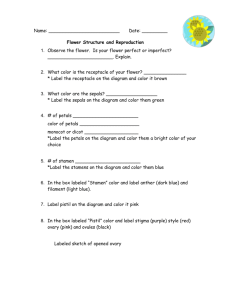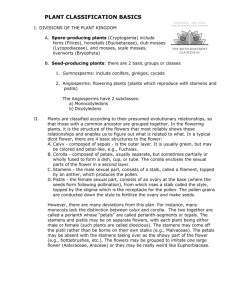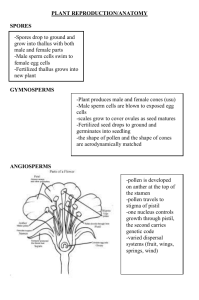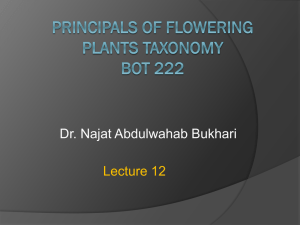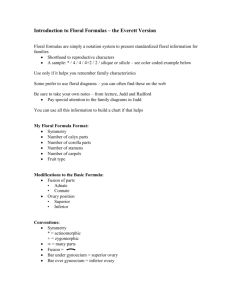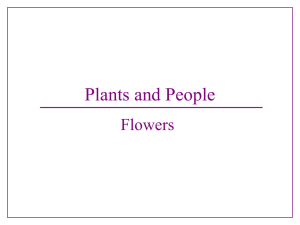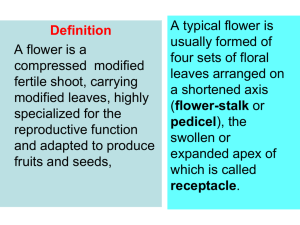Exercise 7
advertisement
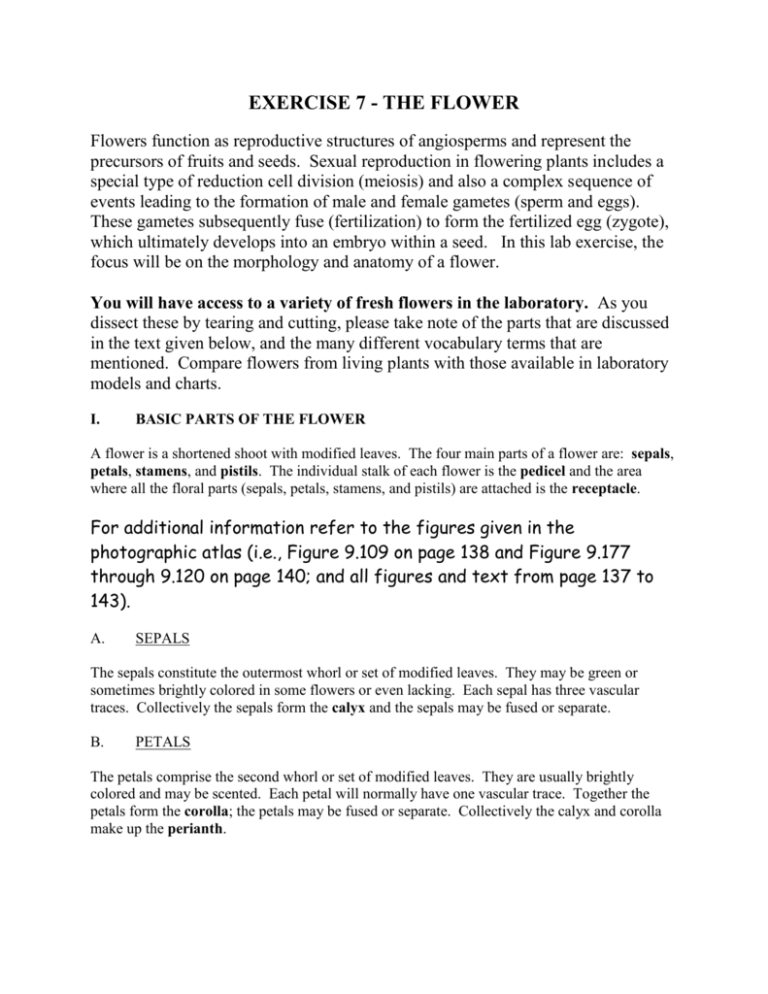
EXERCISE 7 - THE FLOWER Flowers function as reproductive structures of angiosperms and represent the precursors of fruits and seeds. Sexual reproduction in flowering plants includes a special type of reduction cell division (meiosis) and also a complex sequence of events leading to the formation of male and female gametes (sperm and eggs). These gametes subsequently fuse (fertilization) to form the fertilized egg (zygote), which ultimately develops into an embryo within a seed. In this lab exercise, the focus will be on the morphology and anatomy of a flower. You will have access to a variety of fresh flowers in the laboratory. As you dissect these by tearing and cutting, please take note of the parts that are discussed in the text given below, and the many different vocabulary terms that are mentioned. Compare flowers from living plants with those available in laboratory models and charts. I. BASIC PARTS OF THE FLOWER A flower is a shortened shoot with modified leaves. The four main parts of a flower are: sepals, petals, stamens, and pistils. The individual stalk of each flower is the pedicel and the area where all the floral parts (sepals, petals, stamens, and pistils) are attached is the receptacle. For additional information refer to the figures given in the photographic atlas (i.e., Figure 9.109 on page 138 and Figure 9.177 through 9.120 on page 140; and all figures and text from page 137 to 143). A. SEPALS The sepals constitute the outermost whorl or set of modified leaves. They may be green or sometimes brightly colored in some flowers or even lacking. Each sepal has three vascular traces. Collectively the sepals form the calyx and the sepals may be fused or separate. B. PETALS The petals comprise the second whorl or set of modified leaves. They are usually brightly colored and may be scented. Each petal will normally have one vascular trace. Together the petals form the corolla; the petals may be fused or separate. Collectively the calyx and corolla make up the perianth. C. STAMENS The stamens form the third whorl or set of modified leaves and they represent the male reproductive organ of the flower. A stamen may have a stalk called the filament and an expanded portion at the tip called the anther. The anther is where pollen grains are produced and the male gamete (sperm) is produced in the tube of the pollen grain. A stamen which lacks a filament is said to be sessile. Each stamen usually possesses one vascular trace. The stamens collectively form the androecium. (andros = man and oecium = household). D. PISTILS This part represents the innermost modified leaf of the flower. The pistil is the female reproductive organ of the flower and usually has three parts. The uppermost part is the stigma, the middle part is the tubular and is the style, and the basal part is thickened or expanded and is called the ovary. The stigma is usually hairy or sticky, or both, and the pollen grains adhere to the surface. The tubular style connects the stigma and the ovary. The ovary is enlarged and this is where the ovules (immature seeds) originate and eventually the female gamete (egg) is produced. The pistil collectively form the gynoecium (gyne = woman and oecium = household). Technically a pistil is composed of carpels and a carpel is a folded, fertile leaf bearing ovules. A pistil composed of one carpel is a simple pistil and when a pistil is composed of two or more carpels it is compound. Each carpel has three vascular traces. II. FLOWER COMPOSITION A flower which has all four floral parts present (sepals, petals, stamens, and pistils) is called a complete flower. A flower with one or more floral parts missing is incomplete. Thus a flower that lacks stamens, or petals, etc. is incomplete (duckweed). When a flower has both sexes present (stamens and pistils) it is perfect (rose) and when one sex is missing it is imperfect (corn). Flowers that have only stamens are referred to as staminate and flowers having only pistils are called pistillate. Plants with both sexes present on the same plant are called monecious (buttercup, lily). Plants with only one sex present on the entire plant are referred to as dioecious (hedge apple, marijuana). Monocots will usually have floral parts (sepals, petals, stamens, and pistils) occurring in threes or multiples thereof. Dicots will usually have floral parts in fours or fives or multiples thereof. A. ARRANGEMENT OF FLORAL PARTS In flowers the different parts may be arranged in numerous ways. Like parts may be fused (sepals to sepals), or may be distinct, while other parts may be fused to petals. B. SYMMETRY The way the perianth is arranged is termed the symmetry. When the perianth is arranged so that the flower can be divided into equal parts in more than one plane, the flower is said to have regular symmetry (buttercup). When the perianth is arranged so that the flower can be divided into equal halves in only one plane, it is called irregular symmetry (orchid or sweet pea). C. ATTACHMENT When floral parts are attached below the ovary, the insertion of floral parts is said to be hypogynous (mustards). When the floral parts are attached above the ovary, the condition is said to be epigynous (aster). When the floral parts are attached to a disc (hypanthium) which surrounds the ovary, it is said to be perigynous (some members of the rose family). Where floral parts are inserted below the ovary, the ovary is considered superior (lily). When floral parts are attached above the ovary, the ovary is considered inferior (chrysanthemum) and when they are attached to a disc surrounding the ovary; the ovary is referred to as half superior or half inferior (hydrangea). D. PLACENTATION The region where an ovule (immature seed) is attached to the ovary wall is called the placenta and the method of ovule attachment is termed placentation, Placentation can usually be determined by making a cross section of the ovary. When the ovules are attached to the wall of the ovary it is called parietal placentation (garden bean). Basal placentation is where the ovules are attached to the base of the ovary (mints). When the ovules are attached to a column which originates from the base of the ovary, it is termed free–central placentation (pinks). The condition where the ovules are attached to the axis of fused carpels is called axile placentaion (okra). Note that the first three types of placentation will generally occur with a simple pistil. The number of carpels making up the pistil can be determined by making a cross section of the ovary. Each carpel will have one cavity (locule) and the number of carpel cavities in each ovary can usually be counted to determine the number of carpels. Some flowers with a compound pistil will have lobed stigmas and each stigma lobe will usually correspond to a carpel. However, many pistils may be compound and only have an enlarged stigmatic area in which case a cross section of the ovary is essential to accurately determine the carpel number. E. INFLORESCENCE The arrangement of all the flowers on a plant is termed the inflorescence. The inflorescence may consist of all perfect flowers (either pistillate or staminate) or there may be a mixture of imperfect flowers (to include both pistillate and staminate). Some plants may have both perfect and imperfect flowers in the florescence. The main stalk of an inflorescence is called the peduncle and an individual stalk of a flower is the pedicel. A flower which lacks a pedicel is called sessile. Usually occurring below each flower is a leaf-like part called a bract. III. REPRODUCTION A. POLLINATION Transfer of pollen from one flower to another is called pollination. Flowers, which are bright and showy, are insect pollinated and are called entomophilous. Flowers which are wind pollinated are called anemophilous and are usually not showy. B. REPRODUCTIVE PARTS Stamens produce pollen grains in sac-like compartments called microsporangia (anther sacs or pollen sacs). Look at pollen from one of your flowers by making a squash mount or cross section of an anther or view a at a prepared slide or view a prepared slide under the microscope. Look for a vascular trace. What does a vascular trace indicate as to the evolutionary origins of floral parts? Pistils produce ovules (immature seeds) in the ovary. Make a cross section of an ovary and mount with water on a slide. Look for the ovules, number of carpels, and vascular traces. Viewing of a film of David Attenborourgh's The Private Life of Plants: THE BIRDS AND THE BEES.
